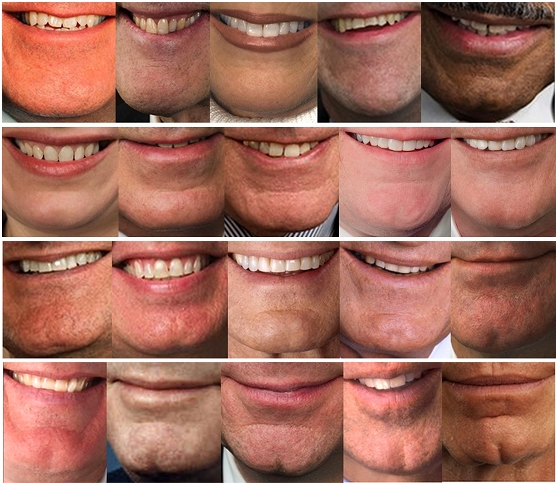Cleft chin: The myth
Some people have a prominent dimple or crease in the front of the chin, called a cleft chin (or "butt chin"); others do not. This is sometimes said to be controlled by a single gene with two alleles, with cleft chin (C) dominant to smooth chin (S). The small amount of genetic data that is available shows that this myth is not true; in addition, there are many chins that are intermediate between clearly cleft and smooth.
The reality
Cleft chin as a character
Cleft chins come in a variety of shapes, including vertical furrows, Y-shaped furrows, and round dimples (Günther 1939). They also vary in depth from barely noticable to extremely prominent (Bhanu and Mahhotra 1972). I looked through a gallery of United States Senators (because they have large official portraits online) and picked out the ones that had some hint of a cleft chin, along with a few smooth-chinned senators for comparison. As you can see, there are a lot of people with vague depressions in the middle of the chin, and few with really unambiguous furrows or dimples. I find it hard to draw a clear boundary between cleft and smooth chins in these pictures.
 |
| Which of these would you call cleft chins? |
The frequency of cleft chin varies widely among different populations; Indian populations range from 4 to 71 percent cleft chin (Bhanu and Malhotra (1972). Günther (1939) recorded cleft chins in 9.6 percent of German men and 4.5 percent of German women. The large difference in frequency between men and women does not fit the simple genetic model of cleft chin being determined by a single autosomal (non-sex-linked) gene. Bhanu and Malhotra (1972) recorded the frequency of cleft chin in Indian boys and men of different ages. They said there was no difference in frequency of cleft chin among age groups, using a chi-square test, but when I analyze the data using logistic regression, I get a significant (P=0.03) increase in cleft chin with age; about 5% of boys 6 to 10 years old have cleft chins, while 10% of men over 35 have a cleft chin. This change with age is also evidence against the simple genetic model.
Family studies
Lebow and Sawin (1941) first suggested that cleft chin was a genetic character, based on data from a single family. They suggested that cleft chin was recessive, although they admitted that they didn't have definitive evidence.
There is an unpublished dissertation by Pfannenstiel (1951), which I haven't seen, that concludes that cleft chin is dominant, but affected by the environment (cited in Beckman et al. [1960]). Beckman et al. (1960) report the following data from Swedish families:
| Parents | Cleft offspring | Smooth offspring | Percent cleft |
|---|---|---|---|
| Cleft x Cleft | 10 | 1 | 91% |
| Cleft x Smooth | 24 | 28 | 46% |
| Smooth x Smooth | 4 | 33 | 11% |
If the myth were true, two parents with smooth chins could not have a child with a cleft chin. While there is definitely a strong genetic influence, as parents with cleft chins have a higher proportion of cleft-chin offspring than do parents without cleft chins, the 4 cleft-chinned offspring from smooth X smooth parents do not fit the myth that cleft chin is determined by a dominant allele.
Conclusion
Many people have chins that are intermediate between clearly cleft and clearly smooth, and the family studies do not fit the myth that cleft chin is caused by a dominant allele. You should not use cleft chin to demonstrate basic genetics.
References
Beckman, L., J.A. Böök, and E. Lander. 1960. An evaluation of some anthropological traits used in paternity tests. Hereditas 46: 543-569.
Bhanu, V., and K.C. Malhotra. 1972. A population genetic study of cleft chin in India. American Journal of Physical Anthropology 37: 367-372.
Günther, H. 1939. Anomalien und Anomaliekomplexe in der Gegend des ersten Schlundbogens. Zeitschrift für menschliche Vererbungs- und Konstitutionslehre 23: 43-52.
Lebow, M.R., and P.B. Sawin. 1941. Inheritance of human facial features: a pedigree study involving length of face, prominent ears and chin cleft. Journal of Heredity 32: 127-132.
Return to John McDonald's home page
This page was last revised December 8, 2011. Its address is http://udel.edu/~mcdonald/mythcleftchin.html. It may be cited as pp. 23-25 in: McDonald, J.H. 2011. Myths of Human Genetics. Sparky House Publishing, Baltimore, Maryland.
©2011 by John H. McDonald. You can probably do what you want with this content; see the permissions page for details.
